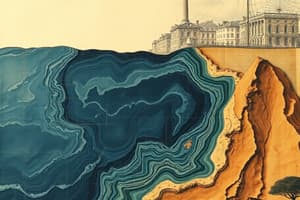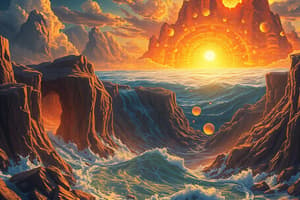Podcast
Questions and Answers
What percentage of Earth's water is seawater?
What percentage of Earth's water is seawater?
- 90%
- 70%
- 97% (correct)
- 80%
How many major oceans are there in the world?
How many major oceans are there in the world?
- Three
- Five (correct)
- Seven
- Nine
Which factor primarily influences the formation of ocean waves?
Which factor primarily influences the formation of ocean waves?
- Wind movement across the surface (correct)
- Temperature differences in water
- Earth's rotation
- Gravitational pull of the Moon
What primarily causes tides?
What primarily causes tides?
Which statement accurately describes the composition of the ocean floor?
Which statement accurately describes the composition of the ocean floor?
Which ocean is the warmest among the three major oceans?
Which ocean is the warmest among the three major oceans?
Who was the first European to view the Pacific Ocean?
Who was the first European to view the Pacific Ocean?
What is the average depth of the Indian Ocean?
What is the average depth of the Indian Ocean?
What significant historical event took place in 1492 related to the Atlantic Ocean?
What significant historical event took place in 1492 related to the Atlantic Ocean?
Which two continents are separated by the Atlantic Ocean?
Which two continents are separated by the Atlantic Ocean?
Flashcards are hidden until you start studying
Study Notes
Oceans - Formation and Facts
- Water vapor from Earth's early volcanic activity formed clouds, which condensed to create oceans over millions of years.
- 80% of Earth's life exists underwater, with only 10% explored.
- Oceans cover 70% of Earth's surface and have an average depth of 3,795 meters.
- Majority of water on Earth (97%) is seawater, which is too salty for drinking.
- Only 2.5% of water on Earth is freshwater, found in lakes, rivers and glaciers.
- Seawater varies in temperature, depth and mineral content.
- Ocean floor is primarily composed of rock, plants, granite and layered ballistic rock.
- Most volcanic activity occurs in the oceans.
Tides - Formation and Influence
- Tides are changes in sea level caused by the relative positions of the Sun, Moon and Earth's rotation.
- The Moon's gravitational pull and Earth's rotation contribute to the rise and fall of tides.
- Tide gauges measure the rise and fall of tides.
- High and low tides occur in successive patterns.
Major Oceans
- The Pacific Ocean is the largest and deepest, covering 63.8 million square miles/165.2 million square kilometers.
- The Pacific Ocean reaches a depth of 6 miles (11 kilometers) near the Mariana Islands.
Pacific Ocean
- The Pacific Ocean is the largest ocean by surface area, encompassing approximately 106 million square kilometers.
- Known for its extreme depth, reaching up to 3,900 meters.
- Despite its size, the Pacific Ocean contains relatively few islands but those islands feature significant geological features like mountain ranges and plateaus.
- The Pacific Ocean was first sighted by Europeans in 1513 when Vasco Nunez de Balboa reached its shores.
- Ferdinand Magellan circumnavigated the Pacific Ocean in 1521 and named it for its calm waters, "Pacifico" in Spanish.
Atlantic Ocean
- The Atlantic Ocean is approximately the same size as the Pacific Ocean, covering 106 million square kilometers.
- It shares similar depths with the Pacific, reaching up to 3,900 meters.
- The Atlantic Ocean boasts significant underwater features like mountain ranges and plateaus.
- The Atlantic Ocean was historically significant for its role in European exploration. In 1492, Christopher Columbus crossed the Atlantic seeking a westward route to India.
- Amerigo Vespucci discovered the new continent (the Americas) and named it after him.
- The Atlantic Ocean receives water from some of the world's largest rivers, including the Amazon, Congo, and Niger.
Indian Ocean
- The Indian Ocean is the smallest of the three major oceans, spanning 74 million square kilometers.
- It is located between Africa and Australia.
- The Indian Ocean possesses an average depth of 890 meters.
- This ocean holds the title of the warmest of the three major oceans.
Studying That Suits You
Use AI to generate personalized quizzes and flashcards to suit your learning preferences.




